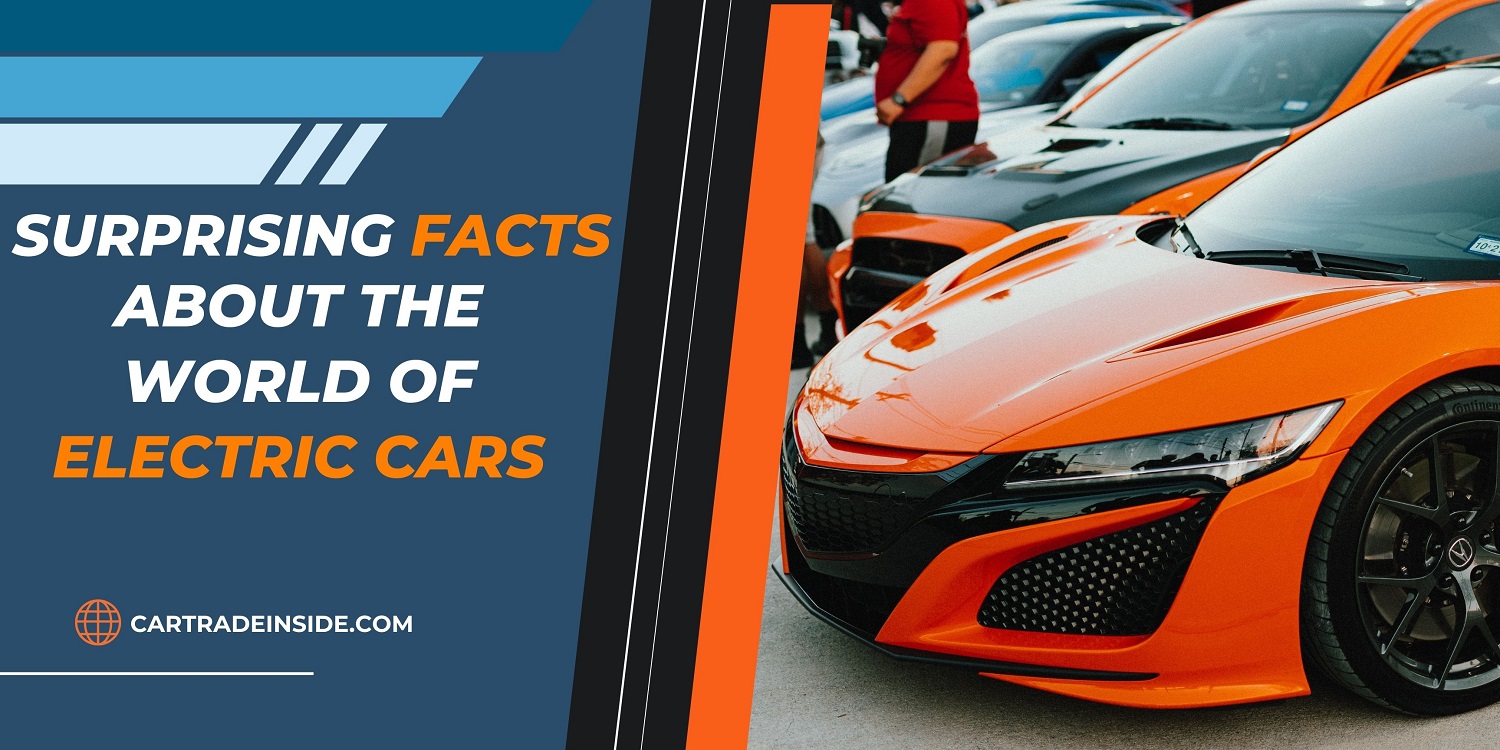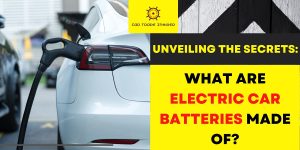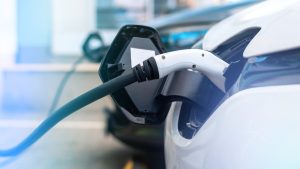Have you ever wondered what it’s like to cruise through the city with a ride that not only turns heads but also leaves a lighter footprint on our planet? Here’s the deal: Electric cars are the not-so-hidden gems of the automotive world.
Electric cars are booming, with diverse options beyond Tesla and there are over 26 million EVs on the road globally. Excitingly, between 2024 and 2025, car giants like Alfa Romeo, Bentley, and even Apple are joining the EV parade.
Think fewer emissions, cleaner air, and a driving experience so smooth it’s like gliding on a cloud. In a world electrified by innovation, electric vehicles (EVs) have seen a 40% global market surge in the last two years.
Unveil the truths and dispel myths as we delve into 30 intriguing Facts about Electric Cars.
What Sets EVs Apart?
Electric vehicles redefine transportation, opting for electric motors over traditional combustion engines. Their rise isn’t a fleeting trend; it’s a transformative shift. A recent survey reveals that 71% of U.S. drivers consider embracing an EV, with a third planning it for their next purchase.
Looking to make the switch to electric? Explore our recommended used car websites for a seamless transition. Find your perfect electric ride now!”
Understanding EV Types:
- Battery Electric Vehicles (BEVs): Run entirely on electricity, producing no exhaust.
- Plug-in Hybrid Electric Vehicles (PHEVs): Combine electric and gas-powered engines, offering flexibility.
- Hybrid Electric Vehicles (HEVs): Use both electric and gas engines, without the need for external charging.
Charging Dynamics:
- AC Level 1: Home charging through a 120V AC plug.
- AC Level 2: Faster charging through a 240V plug, beneficial for homes, workplaces, and public spaces.
- DC Fast-Charge: High-powered charging for quick battery replenishment during long journeys.
1. Silent Revolution:
Electric cars operate quietly, creating a noise reduction of approximately 40% compared to traditional vehicles, contributing to a more peaceful urban environment.
EVs, once celebrated for silent roads, now comply with EU regulations, emitting artificial noises at speeds below 13 mph for pedestrian awareness. Yet, the struggle is real as users adapt to the new rhythm of near-silent drives.
2. Instant Torque:
Electric cars deliver instant torque, with some high-performance models achieving 0-60 mph in less than 3 seconds, showcasing the power of electric motors.
3. A Spark in 1832:
Electric car technology isn’t a recent phenomenon; it dates back to 1884 when Thomas Parker crafted the first mass-produced electric car. In 1832, Scottish inventor Robert Anderson birthed the concept of electric vehicles. By the early 20th century, electric cars dominated urban streets until the Ford Model T arrived in 1908.
4. Eco-Friendly Drive:
While EVs don’t emit CO2, their electricity source matters. Major automakers like General Motors and Tesla are committing to electric futures, yet concerns about mining rare minerals and the lack of cost-effective battery recycling persist.
In simple terms, electric vehicles (EVs) run on batteries that need periodic recharging, similar to our electronic devices. Electric buses silently infiltrate city streets worldwide, curbing air pollution and elevating public transportation.
Industry giants like UPS and DHL are greening their delivery fleets with electric trucks, aligning with sustainability goals. Aviation heavyweights Airbus and Boeing enter the electric race, developing electric aircraft to combat emissions and noise pollution.
Manufacturing EVs has its challenges. Rare earth elements like lithium, cobalt, and nickel are essential but have environmental trade-offs. Mining them, especially in biodiverse regions, poses risks.
5. Regenerative Braking:
Regenerative brakes, found in all U.S. electric and plug-in hybrid vehicles, revolutionize braking efficiency. Unlike traditional systems that turn kinetic energy into wasteful heat, regenerative brakes use electric motors to capture and transfer up to 90% of braking energy back to the car’s batteries.
This innovative technology significantly contributes to range preservation in electric and plug-in hybrid vehicles. Not as reliable at high speeds as traditional friction brakes, regenerative brakes excel in preserving energy during regular driving conditions, making them a valuable asset for eco-conscious hybrid and EV owners.
6. Lower Operating Costs:
Electric vehicles typically have 20% fewer moving parts than traditional cars, resulting in lower maintenance costs and a potential 35-50% reduction in maintenance expenses.
Charging an EV annually costs hundreds less than fueling a gas-powered vehicle. The average yearly fuel cost for an electric car is around $485, a stark contrast to the $1,117 for a traditional vehicle.
Moreover, according to Cox Automotive as of September 2023, the average price for a new EV dropped, making it just $2,800 more expensive than a gas-powered counterpart. Federal tax credits further sweeten the deal, offering up to $7,500 for new EVs and $4,000 for used ones.
Notably, off-peak charging can save up to 30%, and EV maintenance costs are typically half those of gas-powered cars. In essence, despite upfront costs, the long-term savings, combined with environmental benefits, make owning an EV a financially savvy and eco-friendly choice.
7. Battery Innovation:
Battery costs have dropped by around 87% over the last decade, reaching approximately $137 per kWh in 2022, driving increased affordability and adoption of electric cars.
EV batteries propelling your car for 500 miles, or an astounding 1,100 miles on a single charge! The quest for superior batteries is the modern-day gold rush, eliminating the woes of “range anxiety” and long charging times.
Promising technologies include EV batteries integrated as structural components, employing carbon fiber and lithium iron phosphate for lighter, stiffer structures.
Silicon anode batteries, seawater-extracted batteries, and sand batteries are all pushing the boundaries of EV performance. Imagine Wi-Fi-powered cars, over-the-air ultrasound charging, and batteries that recharge in just 5 minutes, setting the stage for an electrifying future.
Buyer Tip: Always check the “range-per-charge” of the EV. This is the distance it can cover on a full charge. With ranges from 80 to over 300 miles per charge, EVs can cater to various needs.
8. Global Growth:
The electric vehicle (EV) surge is reshaping the automotive landscape, with global EV sales predicted to hit 14.1 million units in 2023, showcasing a remarkable 34% growth compared to 2022.
Despite challenges in North America and Europe, EVs are poised for an electrifying future, with global sales projected to triple from 10.5 million in 2022 to over 31 million in 2027 and exceeding 74.5 million units in 2035.
The EV revolution is unstoppable, propelling towards a staggering 68.4% share in the global light-vehicle market by 2035. Get ready for a greener future on wheels!
9. Energy Efficiency:
With an impressive 77% conversion of electrical energy from the grid to power at the wheels, EVs outshine conventional gasoline vehicles, which manage a mere 12%–30% efficiency.
Beyond environmental benefits, electric motors offer silent, smooth operation, robust acceleration, and reduced maintenance compared to traditional internal combustion engines.
Despite these merits, EVs grapple with challenges. Their driving range, while improving, falls short of conventional vehicles, averaging 100 to 300 miles per charge.
10. Smart Features:
Advanced driver-assistance systems in electric cars, such as Tesla’s Autopilot, use sensors, cameras, and radar to provide semi-autonomous driving capabilities, showcasing the integration of cutting-edge technology.
11. Incentives for Green Wheels:
Federal tax credits of up to $7,500 sweeten the deal for EV adopters, with many states offering additional perks like rebates, tax credits, and discounted fees. While upfront costs may be higher, long-term savings emerge through lower operating and maintenance expenses.
The credit applies to both new and used EVs, providing a financial boost to buyers. For 2024, purchasers enjoy the flexibility to claim the credit at the time of purchase, instantly reducing the vehicle’s cost.
Used EV buyers also get a slice of the pie, with a credit of up to $4,000 available. As the automotive landscape electrifies, navigating the tax credit terrain becomes a key consideration for buyers, influencing decisions on vehicle choice and timing.
12. Charging Infrastructure:
The electric vehicle (EV) revolution is gaining momentum in the United States, with a 65% surge in sales in 2022. To support this shift, President Joe Biden signed a trillion-dollar infrastructure bill in 2021, earmarking $7.5 billion for the construction of 500,000 additional public EV chargers by 2030.
Tesla, a global EV leader, is contributing by making 3,500 Supercharger stations and 4,000 Level 2 charging docks available to all EV brands by next year. California leads the US in EV charging stations, with over 14,000 out of approximately 60,000 nationwide.
13. Energy Independence:
Electric vehicles contribute to energy independence, reducing oil consumption by an estimated 45,000 barrels per day globally, and fostering a shift towards sustainable energy sources.
14. Recyclable Batteries:
Manufacturers are developing recyclable batteries, with an estimated 95% of components in electric vehicle batteries being recyclable, minimizing environmental impact and promoting sustainability.
15. Growing Model Range:
Automakers are expanding their electric vehicle model range, with over 500 electric car models expected to be available globally by 2022, offering consumers diverse choices.
16. Performance Boost:
Electric cars often showcase impressive acceleration, with Tesla’s Model S Plaid achieving 0-60 mph in just 1.98 seconds, redefining the notion of high-performance vehicles.
17. Reduced Noise Pollution:
Zero tailpipe emissions make EVs an environmentally friendly choice, contributing to a greener future. The quiet operation of electric cars reduces noise pollution, contributing to an average noise reduction of 5-10 decibels, creating a more tranquil urban environment.
18. Economic Benefits:
The electric vehicle market is projected to generate $800 billion in annual revenue by 2027, creating job opportunities and fostering economic growth within the industry. Emitting no tailpipe pollutants, EVs contribute to a cleaner environment, particularly when powered by ‘green’ sources like solar or wind.
19. EV Racing:
Electric vehicle racing, exemplified by Formula E, features cars reaching speeds of up to 174 mph, showcasing the performance capabilities of electric motors in a competitive racing environment.
20. Innovative Charging Solutions:
Emerging technologies like wireless charging aim to simplify the charging process, allowing electric cars to be charged by parking over a charging pad, and making charging more convenient and user-friendly.
21. Home Charging Habits:
The average cost of charging an EV at home hovers around $56 per month, subject to variables like battery size, driving patterns, and electricity rates.
Charging can be done with a standard 120V outlet or a more efficient 240V charger. This Level 2 EVSE equipment not only reduces charging time but also offers scheduling options for optimal energy use.
22. Tesla Triumph:
Tesla leads the EV pack, known for models like the Model 3 and Model X. Other major players include Toyota, Chevrolet, and Nissan, contributing to the global electric revolution.
In the fast lane of EV supremacy, the Tesla Model Y claimed the 2022 throne as the best-selling electric vehicle, with the Tesla Model 3 securing a close second.
Tesla Model 3 is also reviewed as one of the best cars for long-distance driving.
23. Diverse EV Landscape:
EV terrain is rich and diverse, featuring Hybrid Electric Vehicles (HEVs), Plug-in Hybrid Electric Vehicles (PHEVs), Battery Electric Vehicles (BEVs), and Fuel Cell Electric Vehicles (FCEVs).
24. Stable Drive:
Electric vehicles act as a shield against oil price rollercoasters, as electricity prices maintain a steadier course compared to volatile oil prices.
25. Bolt’s Milestone:
The Chevrolet Bolt set a milestone as the first mass-market electric vehicle for under $50,000 with a range exceeding 200 miles per charge.
EVs are fast-tracking into the car-sharing and ride-hailing arena, with major players like Uber and Lyft embracing electric fleets.
27. Charging Modes:
Owners enjoy diverse charging options, from Level 1 (120V) to Level 3 (DC fast charging), catering to varied preferences. As EV adoption surges, public charging infrastructure expands, providing a map of possibilities for both daily use and cross-country journeys.
28. Mercedes-Benz Dominance:
The Mercedes-Benz EQS leads the range game, boasting over 450 miles per charge, setting a new benchmark.
29. Global EV Pioneers:
In 2022, China raced ahead, claiming over half the world’s electric cars—13.8 million in total, marking a significant milestone. With nearly 60% of new electric car registrations, China is steering the global electric revolution.
30. Employment Acceleration:
The transition to EVs holds the promise of creating over 150,000 jobs in the U.S. by 2030, aligning economic growth with sustainability.
Common Myths and Misconceptions
Electric vehicles (EVs) are not just the futuristic dreams of environmental enthusiasts; they are the reality of today’s automotive landscape. Let’s navigate through the buzzing myths surrounding electric cars and unveil the truth behind the wheel.
Myth 1: Limited Range Anxiety
- Misconception: Electric cars can only travel short distances before running out of juice.
- Reality: With advancements in battery technology, many electric cars can now travel over 400 miles on a single charge, making them suitable for various types of journeys.
Myth 2: Short Battery Lifespan
- Misconception: Electric car batteries degrade quickly, leading to frequent and costly replacements.
- Reality: With warranties around 8 years and over 10 million EVs on the road, the myth of quick battery deaths is just that—a myth. Modern electric (EV) batteries typically last 15 to 20 years in the car and often have a second life.
Myth 3: Lack of Charging Infrastructure
- Misconception: Finding a charging station is a hassle, limiting the practicality of electric cars.
- Reality: Many cities now have a growing network of charging stations. With over 60,000 public charging stations and a commitment to 500,000 charging ports by 2030, infrastructure is expanding.
Myth 4: Slow Charging Times
- Misconception: Charging an electric car takes forever, especially when compared to a quick stop at a gas station.
- Reality: EVs charge up to 80% in just 30 minutes, demonstrating swift progress in charging technologies and infrastructure. Enter Tesla’s Superchargers, the speed demons of EV charging. With over 50,000 global Superchargers, you can juice up your vehicle up to 200 miles in just 15 minutes. With a Level 2 charging unit, bid farewell to gas stations and embrace the convenience of a fully charged vehicle every morning.
Myth 5: High Purchase Costs
- Misconception: Electric cars are too expensive to buy.
- Reality: While the initial purchase cost may be 10-40% higher, various government incentives, tax credits, and decreasing battery costs make electric cars increasingly affordable. Plus, the long-term operational savings can offset the upfront expense.
Myth 6: Same Environmental Impact as Gasoline Car
- Myth: EVs have the same environmental impact as gasoline cars.
Reality: With zero tailpipe emissions, EVs significantly reduce climate change pollutants.
By addressing these myths, we aim to provide clarity and encourage a more informed perspective on the electric vehicle landscape.
Conclusion:
The electric vehicle landscape continues to evolve, with advancements in battery materials, charging methods, and government incentives. Embracing this eco-friendly mode of transport is not just a choice; it’s a commitment to a sustainable future.
In conclusion, the electric vehicle revolution is not just a trend—it’s a seismic shift toward cleaner, efficient, and forward-thinking transportation. As myths dissipate, the road ahead is paved with innovation, making EVs a cornerstone of the automotive future.
Looking for the perfect electric ride? Dive into our guide on the best car dealerships to find the perfect electric vehicle. The road to sustainability starts with the right dealership!”





